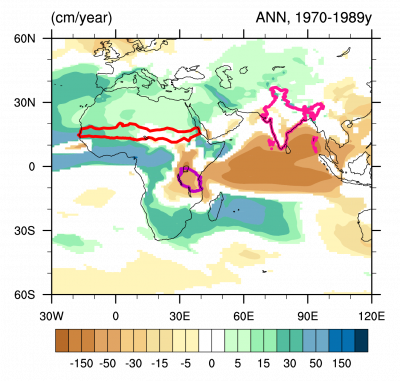
Simulation points out possibilities and pitfalls of regional geoengineering schemes (Scripps)
Model demonstrates that ending drought in one African region reduces rainfall in another
A research team led by Scripps Institution of Oceanography at UC San Diego modeled a hypothetical solution to a drought that really had plagued Africa’s Sahel region in the 1970s and 80s.
The solution was to use a collection of pipes to pump cold water from beneath the neighboring Indian Ocean’s warm upper layer to the surface, a process known as artificial upwelling, setting in motion an atmospheric response that would have led to more rainfall in the Sahel.
The study demonstrates a novel approach to geoengineering – the practice of manipulating elements in nature to avoid damage from climate change. Lead author Kate Ricke, a climate scientist with appointments at Scripps Oceanography and UC San Diego’s School of Global Policy and Strategy, said the work is one of the few to consider regional-scale geoengineering schemes. Most thought on the matter has focused on global-scale interventions by society.
“With global geoengineering schemes, models indicate you need to make very large disruptions to the earth’s energy balance in order to reverse negative impacts from climate change,'' said Ricke. “The prospect of a regional intervention that targets a particular negative impact is very appealing in some ways: Maybe you could get impact reductions without having to tinker too substantially with the earth system.”

The problem was, the researchers found, that the solution to the Sahel’s drought also caused drought conditions in sub-Saharan East Africa. Additionally, basic engineering calculations suggest a government or private enterprise would have needed to install millions of pipes in the Indian Ocean for the scheme to be effective.
“It’s the first modeling experiment on climate geoengineering that targets a climate teleconnection,” Ricke said. “The idea is we're hitting a pressure point in Earth’s climate system, changing something in one place in order to have a strong effect somewhere else in the world.”
The researchers used a National Science Foundation-supported model called Community Earth System Model to create computer simulations in which surface water in the central Indian Ocean is cooled by artificial upwelling of deep ocean water to the surface. The researchers found that the intervention sharply increased rainfall for countries in the Sahel such as Nigeria and Ethiopia but it fell off in other countries such as Tanzania and Mozambique to the south. The intervention also stanched rainfall to a lesser degree in parts of Southeast Asia and the Arabian Peninsula ringing the Indian Ocean. The model even suggested that rainfall could increase as far away as Central America.
The exercise points out the real-world problems that nearly any geoengineering effort would face. Researchers largely agree that all geoengineering schemes pose the risk of unintended consequences to some degree. The task of identifying those consequences has been pursued by a global community of scientists who use computer modeling to consider a select set of scenarios, but the field is still relatively young.
“The research also highlights that understanding geoengineering impacts is directly dependent on understanding basic climate dynamics and that both research directions can inspire each other,” said study co-author Maria Rugenstein of Colorado State University.
And yet, Ricke’s study coincides with experiments under way in Australia and China to manipulate nature to curb global warming effects.
“These research programs indicate that some major actors are closely considering unconventional options for mitigating the risks presented by climate change which are more regionally targeted, and perhaps constrained as much by geopolitical and legal considerations as physical objectives," Ricke said. “Earth system modeling of geoengineering activities should consider delving more into these regional schemes because the physical outcomes might be quite different.”
Co-authors of the study, which appears in the journal Geophysical Research Letters, include Detelina Ivanova and Taylor McKie of Scripps Oceanography.
source Scripps, UC San Diego : ici
